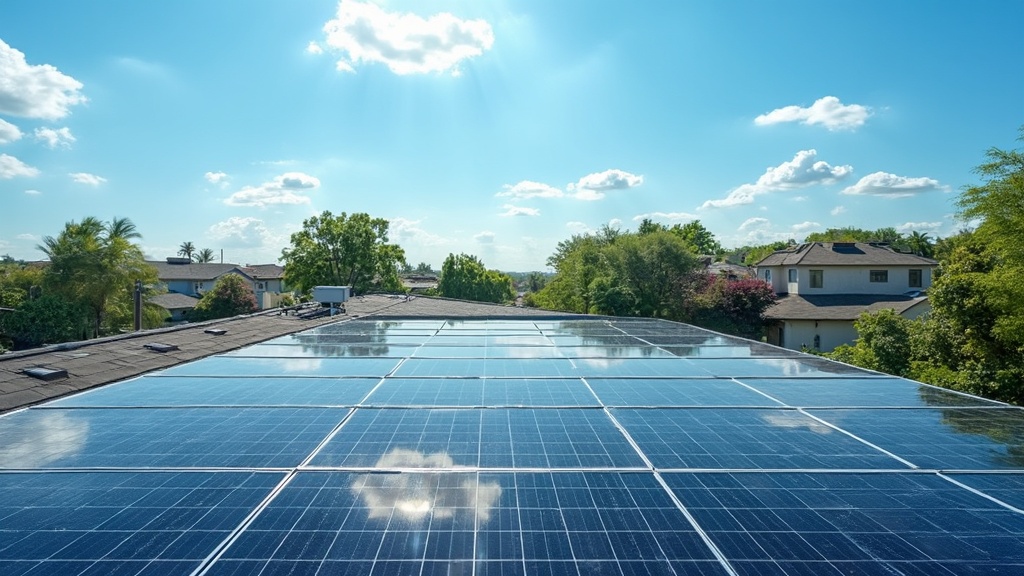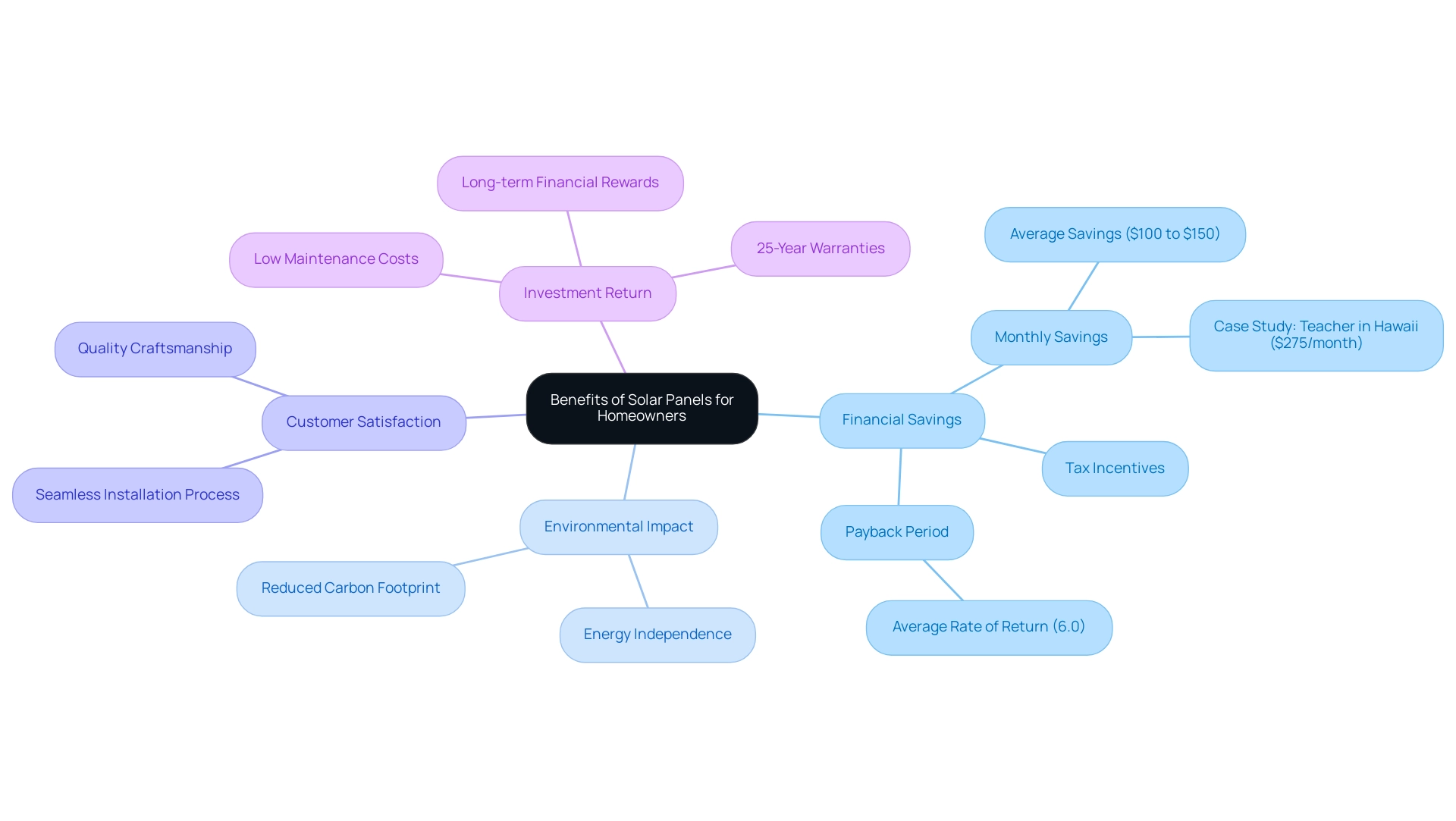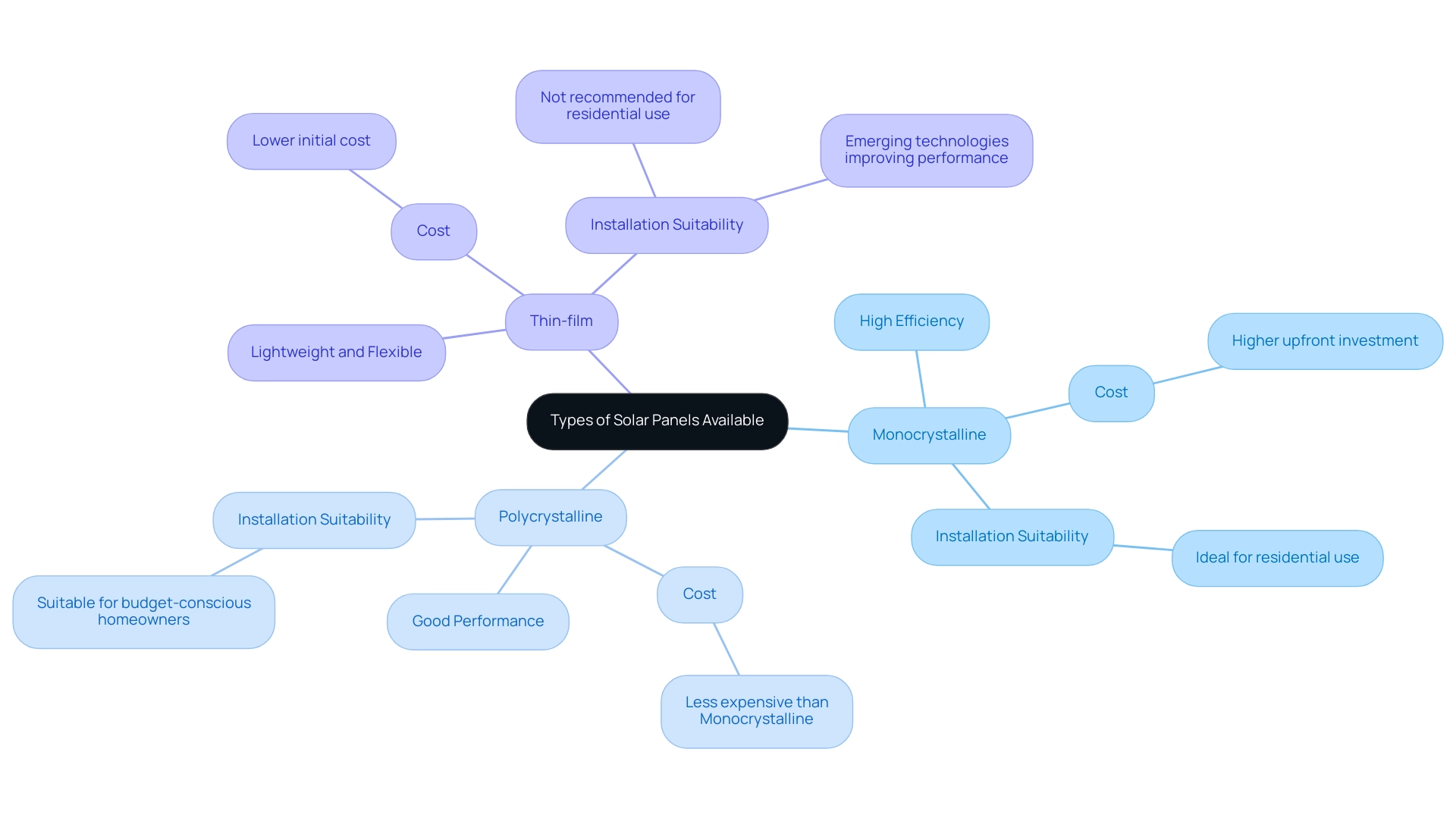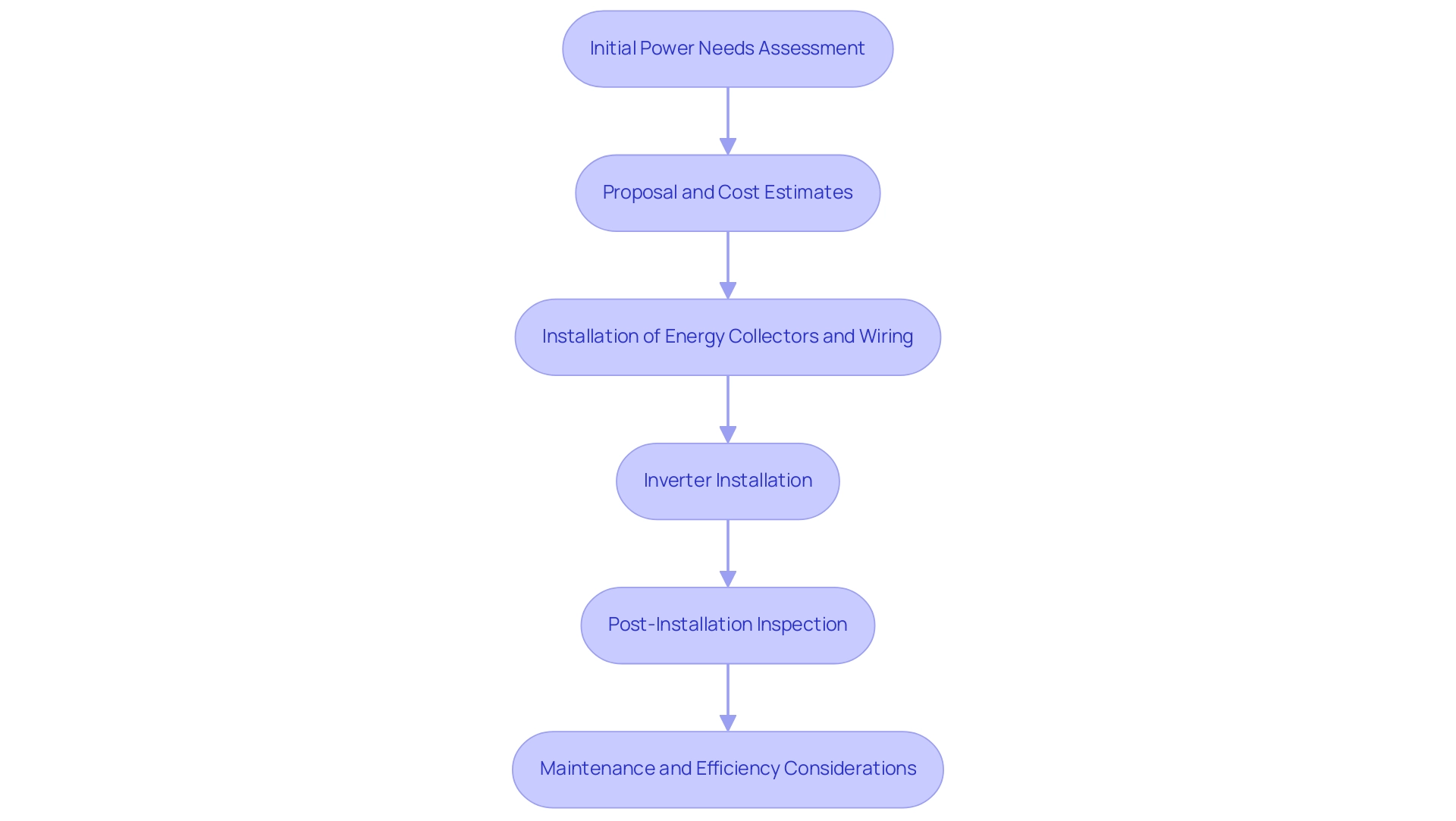Introduction
Harnessing the power of the sun has never been more accessible or appealing for homeowners. As solar technology advances and costs decline, the prospect of installing solar panels transforms from a mere idea into a practical solution for energy savings and environmental stewardship.
From understanding the mechanics behind photovoltaic systems to exploring the myriad benefits they offer, this guide delves into the essentials of solar energy for residential use. Homeowners will discover:
- The different types of solar panels available
- The step-by-step installation process
- The importance of maintenance to ensure longevity and efficiency
With insights into financial incentives and real-world success stories, this article aims to illuminate the path toward a sustainable future powered by clean energy.
Understanding How Solar Panels Work on Your Home
Solar panels, commonly called photovoltaic (PV) panels, capture the sun’s power to generate electricity through an incredible process known as the photovoltaic effect. When sunlight strikes the photovoltaic cells, it excites electrons within the material, creating direct current (DC) electricity. This electricity is then transformed into alternating current (AC) by an inverter, making it compatible with your home appliances.
Property owners can link their photovoltaic systems to the grid, enabling them to draw electricity when the sun isn’t shining and return any excess power back to the grid. This not only assists in lowering expenses but can also earn credits on utility bills. As of 2024, states like Connecticut, Delaware, and Pennsylvania are enhancing this appeal with Solar Renewable Energy Certificate (SREC) programs, making this energy source even more accessible and financially attractive for homeowners.
Comprehending battery capacity and power ratings is essential for efficiently handling your home’s power requirements; it guarantees that your renewable setup can meet demand while enhancing sustainability. Aligning the storage unit’s capacity and power specifications with your home electricity requirements is essential for maintaining continuous power during high demand periods. Additionally, with the rise in popularity of eco-friendly practices, consider top-rated panel cleaning services like Sunshine Cleaners and Eco-Clean to maintain efficiency and prolong the life of your installation.
Real-world examples of solar panel on a house demonstrate their efficiency and effectiveness, showcasing how tailored installations can meet specific energy needs while contributing to a greener planet. As emphasized by industry specialists such as Juan Matson from Rolls-Royce Solutions America Inc. and Josh Lutton, president of Certasun, the financial attractiveness of residential energy and storage solutions is increasing as expenses decrease, rendering them a wise investment for the future.
The Benefits of Solar Panels for Homeowners
Installing a solar panel on a house brings a wealth of benefits for homeowners, particularly regarding financial savings and environmental impact. Typically, a 5 kW home energy setup can reduce electricity expenses by $100 to $150 each month, with certain homeowners even benefiting from savings exceeding 50%. For instance, a teacher in Hawaii shared that she saves $275 a month from her energy system, netting $125 after costs, while also enjoying the peace of mind that comes with battery backup during outages.
Another satisfied customer in Long Beach noted how Powercore Electric’s team guided them through the entire installation process, making it seamless and stress-free. Here in California, especially in regions such as Long Beach, Powercore Electric focuses on customizing energy solutions to address the distinct requirements of our local communities. We provide insights into essential programs and guides for renters to access eco-friendly power solutions, ensuring that everyone can benefit from sustainable resources.
Our guide for Long Beach renters includes steps to assess their power requirements, access state incentives, and connect with local resources for installation. Many states, including California, provide appealing incentives and tax credits that can significantly reduce the initial installation expenses, making renewable energy more accessible than ever. With an average after-tax rate of return of 6.0% needed to match energy savings for a payback time of 25 years, homeowners can see a solid financial return on their investment.
Beyond the financial perks, photovoltaic panels require little maintenance over their lifetime, and the best brands offer comprehensive 25-year warranties, addressing concerns about long-term reliability. Additionally, Powercore Electric is committed to unmatched quality craftsmanship, ensuring every installation meets the highest standards. Our commitment to sustainability ensures that our energy-efficient solutions are crafted to minimize your carbon footprint while maximizing savings.
Furthermore, EnergySage provides a method to calculate the solar payback period by considering the total cost of the solar system, upfront incentives, and annual savings on electricity, helping homeowners understand their savings potential and compare it to other investment opportunities. Solar installations also play a vital part in decreasing carbon footprints by producing clean, renewable power, which diminishes our reliance on fossil fuels. This shift not only contributes to a healthier planet but also grants homeowners greater energy independence, shielding them from the unpredictability of utility prices.
With such compelling advantages, including customer satisfaction and local expertise, a solar panel on a house stands out as a wise investment for eco-conscious homeowners eager to enhance their sustainability efforts while reaping long-term financial rewards.
Types of Solar Panels Available
When it comes to photovoltaic systems for your residence, particularly the solar panel on a house, you’ve got three main contenders:
- Monocrystalline
- Polycrystalline
- Thin-film types
Monocrystalline units stand out for their high efficiency and sleek, modern appearance, making them a favorite among homeowners ready to invest a bit more upfront. The Department of Energy’s National Renewable Energy Laboratory (NREL) is a leader in high-efficiency solar cell research, highlighting the advancements being made in this area.
Polycrystalline modules, on the other hand, offer a solid balance—they’re typically less expensive and still deliver good performance, making them an attractive option for those on a budget. Now, you might find thin-film modules appealing due to their lightweight and flexible design, which can be perfect for unique installation scenarios. However, it’s important to note that they are generally not recommended for residential installations due to poorer performance and durability, making their low cost less worthwhile.
Despite this, advancements in thin-film technology are emerging, with several modules gaining traction as competitors to crystalline silicon panels. Comprehending these choices is essential, particularly given that water heating solutions fueled by the sun can save homeowners between $400 to $600 annually on utility costs. Furthermore, these systems can prevent approximately 2 tons of carbon dioxide from entering the atmosphere each year, which is comparable to not operating a vehicle for four months.
With new PV installations growing by 18% in 2020 and accounting for 39% of global power capacity additions, emerging technologies like predictive analytics and artificial intelligence are further optimizing heating performance. Identifying the appropriate renewable solution, like installing a solar panel on a house, can lower utility expenses, improve independence, and encourage sustainability for your residence.
Installation Process and Considerations
Starting your path to utilize sunlight for your residence begins with a welcoming discussion to comprehensively assess your power requirements and evaluate the potential for a solar panel on a house. This initial step is crucial, laying the groundwork for a detailed proposal that outlines the design and provides transparent cost estimates. Once you provide approval, anticipate the installation process to occur within only a few days, where energy collectors are expertly mounted, wiring is connected, and the inverter is installed to convert sunlight into usable energy.
After installation, a concluding examination verifies adherence to local regulations, crucial for seamless system functionality.
Understanding how photovoltaic systems operate is essential, as they convert sunlight into electricity through photovoltaic cells, which produce direct current (DC) that is then transformed into alternating current (AC) by the inverter, particularly when using a solar panel on a house. Regular maintenance, including cleaning the surfaces and checking for shading or debris, is vital for ensuring efficiency and longevity. As environmentally aware property owners, it’s crucial to take into account elements such as roof orientation, shading, and local climate conditions, as these greatly affect the efficiency of a solar panel on a house.
Be aware that after installation, local authorities will conduct inspections, and you’ll need permission from your utility company—this can take from a few days to several weeks. The present market conditions suggest that elevated projections of panels accumulated in 2023 could result in installations in 2024, mirroring continuous supply chain advancements.
Additionally, major corporations such as Amazon, Google, and Meta are investing significantly in renewable power, with a combined contracted pipeline surpassing 25 GW. Recent trends show a growing emphasis on backup battery installations, with many homeowners prioritizing resilience over mere financial savings. Optimal battery selections for power storage, such as lithium-ion batteries, can significantly improve your sunlight system’s efficiency and reliability.
This shift emphasizes the changing environment of renewable solutions in our homes, making it a crucial time to examine your choices. For Long Beach renters, understanding local incentives and programs available for solar installation can further facilitate access to eco-friendly power solutions.
Maintenance and Longevity of Solar Panels
Solar modules are designed for longevity and efficiency, typically requiring minimal maintenance to keep them performing at their best. However, ensuring they stay clean is crucial for maximizing their power production. Regular inspections are a smart practice; checking for debris, dirt, or shading can significantly enhance performance.
It’s advisable to clean your surfaces occasionally—especially after heavy storms or periods of dust accumulation—to ensure they remain efficient. As an expert noted, “Did you notice a significant drop in energy production? This could be due to dust accumulation, which can block sunlight and hinder performance.”
Most photovoltaic systems are supported by guarantees lasting from 20 to 25 years, offering homeowners reassurance regarding their investment. With the average efficiency of commercially available photovoltaic modules hovering around 20-22% and high-end models exceeding 25%, it’s clear these systems are designed for durability. Innovations like PERC technology further enhance performance standards.
Environmental factors, such as particulate matter concentration and local climate conditions, can significantly affect the efficiency of photovoltaic systems. For instance, areas with higher dust accumulation may require more frequent cleaning to maintain optimal energy production. Additionally, the expense of photovoltaic panels continues to decline, making now an excellent time to consider making the switch.
Government initiatives may also offer financial incentives for homeowners seeking to install photovoltaic setups. Furthermore, maintenance costs can vary, but simple upkeep can help reduce losses, ensuring your solar energy systems provide reliable benefits for decades to come. By committing to regular maintenance and cleaning, you not only enhance efficiency but also contribute to a more sustainable and eco-friendly home.
Conclusion
Harnessing solar energy presents a remarkable opportunity for homeowners to embrace sustainability while enjoying substantial financial benefits. This guide has explored the intricacies of solar panel technology, from understanding the mechanics of photovoltaic systems to the various types of panels available. Whether opting for the high efficiency of monocrystalline panels or the cost-effectiveness of polycrystalline options, each choice can significantly impact both energy savings and environmental stewardship.
The installation process, while straightforward, requires careful consideration of individual energy needs and local regulations. With the right installation team, homeowners can enjoy a seamless transition to solar energy, ensuring that their systems operate efficiently from day one. Furthermore, the importance of ongoing maintenance cannot be overstated; a little attention can go a long way in maximizing the performance and longevity of solar panels.
Beyond the immediate financial savings, investing in solar energy contributes to a cleaner planet by reducing reliance on fossil fuels. With incentives and programs available in many regions, going solar is not only an environmentally sound decision but also a financially savvy one. As more homeowners transition to renewable energy, the collective impact will foster a sustainable future for everyone. Now is the time to take the leap into solar energy and be part of this transformative movement towards a greener, more self-sufficient lifestyle.







